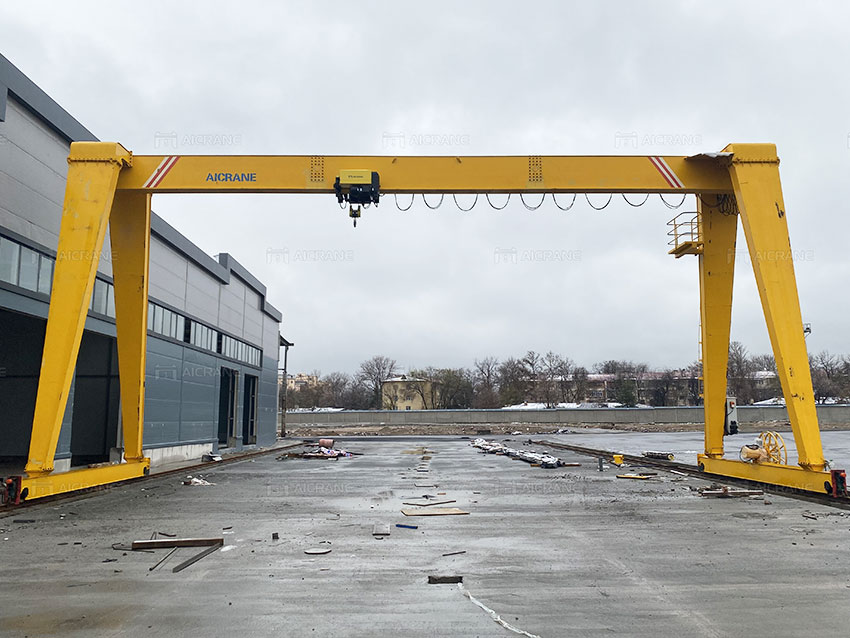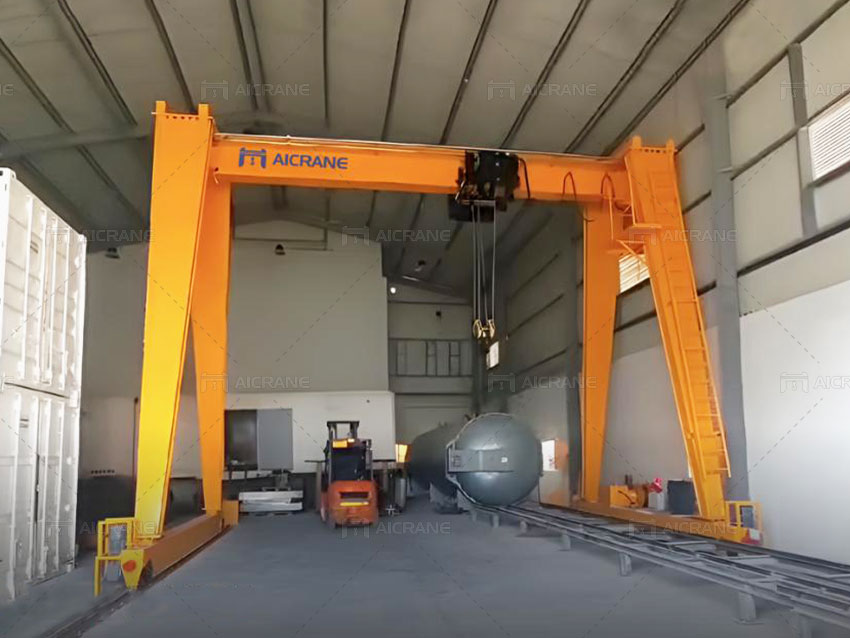Single girder gantry cranes are widely used in various industrial and construction applications due to their efficiency, versatility, and relatively lower cost compared to double girder cranes. These cranes are primarily employed in tasks such as lifting and transporting heavy loads within a confined space, especially in warehouses, production plants, and construction sites. However, as with any lifting equipment, it is crucial to understand the load limitations and safety considerations to ensure smooth and safe operations.
This article will explore the load limitations and safety considerations associated with single girder gantry crane for sale, offering insights into how businesses can maximize productivity while maintaining a safe work environment.

Understanding Single Girder Gantry Cranes
A single girder gantry crane consists of a single beam (or girder) that supports the hoist, which moves along the beam to lift and transport materials. The hoist typically moves horizontally along the gantry rail, which is supported by a set of legs that run on wheels or rails, depending on the crane’s design. Unlike double girder gantry cranes, which have two beams, single girder cranes are more compact and lighter, making them suitable for lifting moderate to heavy loads in smaller spaces.
While these cranes are cost-effective and suitable for a wide range of applications, understanding their limitations is essential to prevent overloading and ensure the longevity of the equipment.
Load Limitations for Single Girder Gantry Cranes
The load capacity of a single girder gantry crane is influenced by various factors, including the crane’s design, the materials used in construction, and the type of hoist installed. Below are some key aspects to consider when determining the load limitations of these cranes:
1. Crane Design and Construction
-
Structural Integrity: The crane’s structural components, such as the girder, support beams, and legs, are designed to handle specific weight loads. Manufacturers typically specify the maximum load capacity for the crane, which is determined based on the strength of the materials used, such as steel or aluminum, and the overall design of the crane.
-
Span Length: The length of the crane’s span (distance between the two support legs) affects the load capacity. Longer spans generally reduce the lifting capacity, as the structure must distribute the weight over a greater distance. Therefore, the span should be carefully considered in relation to the crane’s weight rating.
-
Height of Lift: The lifting height also impacts load limitations. As the height increases, the crane may experience additional stress on its components, particularly at higher lifting heights. Thus, cranes designed for higher lifts must be built with reinforced structural components to ensure safety.
2. Hoist Capacity
-
The hoist is the key component that directly impacts the lifting capacity of the gantry crane. Hoists typically have different load capacities depending on their motor size, rope or chain type, and mechanical design. It is essential to select a hoist that complements the overall gantry crane capacity to avoid exceeding the maximum safe lifting weight.
-
Many hoists also have a rated load limit, often indicated on the unit itself, which should not be exceeded under any circumstances.
3. Load Distribution
-
Load Center: The distribution of the load on the crane plays a significant role in determining the safe operating limit. The load should be evenly distributed across the crane’s lifting area. If the load is concentrated in one spot, it may lead to uneven stresses on the crane structure, increasing the risk of failure.
-
Load Shape and Stability: Irregularly shaped or unbalanced loads can place uneven pressure on the crane, reducing its effective load capacity. When lifting loads that are unstable or irregularly shaped, it’s essential to use rigging techniques that help stabilize the load.

4. Duty Cycle and Load Types
-
The duty cycle refers to the frequency and duration of crane use. Heavy duty gantry cranes that are subjected to continuous use or heavy lifting tasks require a higher safety factor and may need to be rated for a higher load capacity to handle the increased stress over time.
-
Cranes should be rated for specific load types, whether they are static or dynamic loads. Static loads are heavier and more stable, whereas dynamic loads (such as moving materials or equipment) create more stress on the crane and reduce its effective load capacity.
Safety Considerations for Single Girder Gantry Cranes
Ensuring the safe operation of single girder gantry cranes is vital for both the workers operating the crane and the integrity of the equipment. Several safety considerations should be addressed to mitigate risks and maximize performance.
1. Regular Inspections and Maintenance
-
Routine inspection and maintenance are essential for identifying wear and tear on key components such as the girder, hoist, and rails. Regular checks of the load-bearing components, safety devices (such as limit switches and overload protectors), and mechanical systems can prevent equipment failure.
-
Preventative maintenance, including lubrication and cleaning of moving parts, is also critical to ensure smooth crane operation and prevent unnecessary wear that could lead to unsafe conditions.
2. Operator Training
-
Proper training for crane operators is one of the most critical factors in ensuring safe crane operation. Operators must be familiar with the crane’s load capacity, how to assess the load, and the appropriate rigging techniques. Training should include how to recognize and avoid overloading the crane, as well as how to handle specific situations like lifting irregularly shaped loads or working in windy conditions.
-
Operators should also be trained in emergency procedures, such as responding to sudden crane malfunctions or power outages.
3. Overload Protection Systems
-
Many modern single girder gantry cranes are equipped with overload protection systems to prevent lifting beyond the rated load capacity. These systems can include mechanical or electronic overload limiters that automatically stop the overhead gantry crane from lifting excessive loads, preventing damage to the crane or the load.
-
It is crucial that these systems are regularly tested and calibrated to ensure their effectiveness.
4. Environmental Factors
-
Environmental conditions can significantly impact the performance of a single girder gantry crane. Factors such as wind, rain, temperature, and humidity can affect the crane’s ability to lift safely. In particularly windy conditions or extreme weather, operations should be suspended to avoid putting undue stress on the crane.
-
The working surface or track should also be stable and level. Uneven or soft ground can cause the crane to tip or become unstable, increasing the risk of accidents.
5. Rigging and Load Handling
-
Proper rigging is essential for safe lifting operations. The use of appropriate lifting slings, chains, and hooks is critical in ensuring the load is balanced and secure during transportation.
-
Workers should be vigilant about the proper alignment of the load and crane during lifting operations. Any sudden movement or jolt can cause the load to swing, potentially leading to accidents or damage.
6. Limit Switches and Safety Devices
-
Safety limit switches should be installed to prevent the hoist from traveling beyond its designated range. These limit switches can stop the hoist from lifting too high or lowering too far, which could damage the crane or the load.
-
Anti-sway systems can also be used to help stabilize the load and minimize dangerous swinging during lifting operations.
Conclusion
Single girder gantry cranes offer excellent performance and versatility in many lifting applications. However, to ensure safety and efficiency, it is essential to understand their load limitations and incorporate safety measures into daily operations. By adhering to manufacturer specifications regarding crane and hoist capacities, ensuring regular inspections and maintenance, and investing in operator training, businesses can maximize crane productivity while minimizing risks.
Operators and maintenance personnel should always be aware of the factors that influence the crane’s load capacity, including the span length, hoist type, and duty cycle. Ultimately, by following proper safety protocols and guidelines, single girder gantry cranes can continue to provide reliable, cost-effective solutions for lifting heavy materials while ensuring the safety of workers and the integrity of the equipment.